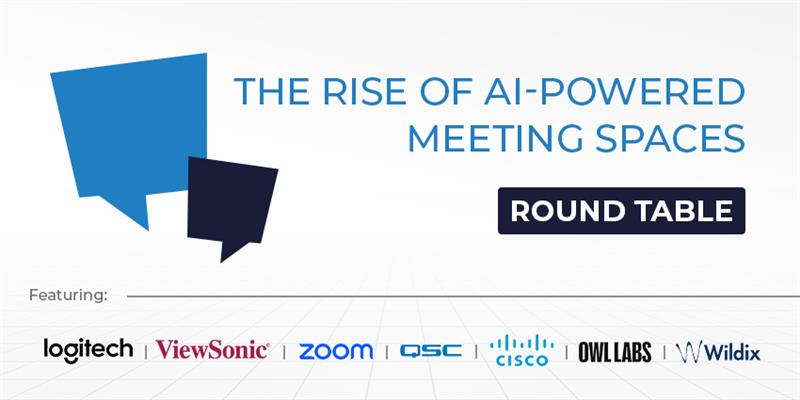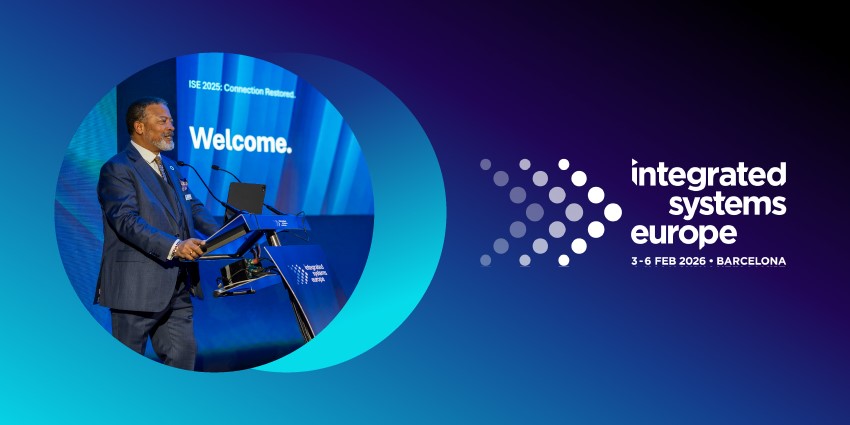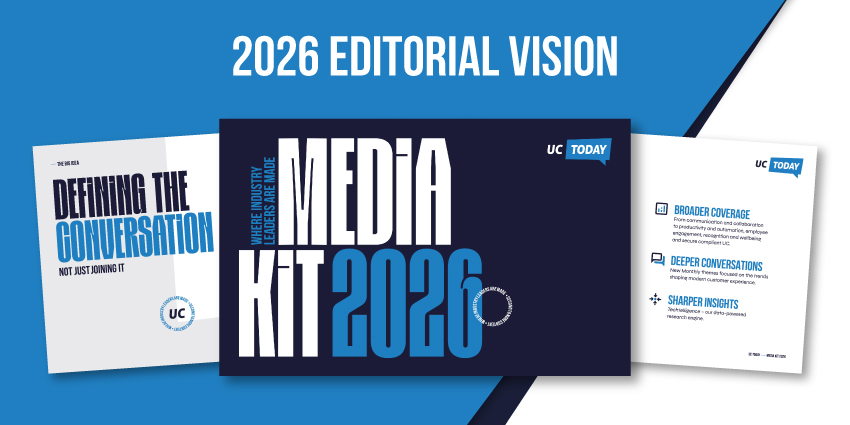UC is entering a new phase, where AI is no longer an add-on, but the engine transforming how teams collaborate, communicate, and connect.
Meeting spaces, in particular, are undergoing a radical evolution. From intelligent transcription and automation to AI-powered insights and immersive experiences, the workplace is becoming smarter, more adaptive, and increasingly driven by real-time data.
Yet with this transformation comes complexity. Organizations must navigate interoperability issues, legacy infrastructure, employee upskilling, and questions of trust, privacy, and governance.
The challenge lies not only in adopting AI, but in implementing it meaningfully, strategically, and ethically while ensuring it enhances the human experience.
For our latest UC Round Table topic, “The Rise of AI-Powered Meeting Spaces,” we spoke with experts and executives from Logitech, ViewSonic, Zoom, QSC, Cisco, Owl Labs, and Wildix about the key trends shaping the modern meeting space, the barriers to seamless AI integration, the balance between productivity and privacy, and what the next five years hold for AI in workplace collaboration.
A Few Years Into the AI Revolution, What Are the Major and Latest Trends in How AI is Shaping Meeting Spaces in 2025?
AI’s impact on meeting spaces in 2025 is more than just a continuation of previous trends; it represents a fundamental reimagining of what collaboration means in the hybrid work era.
Holly Zhou, Senior Product Marketing Manager, Logitech

Zhou notes that AI is now essential to Logitech’s vision of “simple, smart, sustainable” meeting spaces. Features like
Logitech RightSight and RightSound, long in development, have reached new heights of intelligence and utility in 2025.
“Smart office tools, such as automated desk and room booking systems, interactive maps and environmental sensors, are also building the workplace experience and are largely dependent on AI tools, like the Logitech AI Viewfinder… These intelligent experiences, driven by AI, have become a key part of the modern meeting space.”
Dennis Lin, General Manager of the Presentation Group, ViewSonic
Lin distinguishes between consumer-grade and enterprise-grade applications of AI. While individuals may use AI for transcription and translation, enterprises benefit most when AI is fully embedded across their systems.
“Corporate environments benefit from more integrated solutions, where AI is built into supported hardware and software systems… The focus shifts to optimizing the full meeting journey, from agenda planning and content summaries to environmental control.”

John Stearns, Head of Zoom Spaces
Stearns explains that meetings in 2025 are increasingly orchestrated by AI from start to finish, enhancing productivity, clarity, and strategic alignment.
“Agentic AI can now create agendas, find relevant materials, assign tasks, and generate smart summaries… Context-aware and industry-specific AI assistants understand team dynamics and sector-specific language, offering tailored insights and smarter recommendations.”
Jeff Fox, Senior UC Product Marketing Manager, QSC
Fox observes that AI has become a baseline expectation. The shift is toward real-time automation that adapts meetings dynamically.
“Our Q-SYS VisionSuite uses AI for real-time automation—like voice proximity analysis, dynamic camera control, and voice activity detection… The result: more natural, responsive experiences for both in-room and remote participants.”

Mark Rankin, Distinguished Architect, Cisco
Rankin emphasizes Cisco’s AI-led shift toward “distance-zero” experiences—technology that erases the barrier between remote and in-person.
“We are pushing the boundaries even further by introducing Cinematic meetings with an ‘AI director’ orchestrating the video meeting experience… For example, we can seamlessly handle a stage-based presenter and audience questions, or observe the reactions of attendees in a room.”
Frank Weishaupt, CEO, Owl Labs
Weishaupt focuses on reliability and accessibility, stressing that AI should adapt to users—not the other way around.
“AI is also transforming how people participate and contribute… In meetings, this often looks like employing features like real-time transcription or making use of AI-powered cameras that automatically focus on the person speaking.”
Stewart Donnor, Global Head of Sales Engineering, Wildix
Donnor frames the evolution as a move from AI as novelty to AI as necessity. For teams not leveraging AI, the gap is widening.
“Today’s AI is an always-on assistant… The real shift happening now is moving from generic automation to Agentic AI—AI with purpose… It’s strategic, outcome-driven intelligence that can act on its own, adapt based on feedback, and actively help teams meet specific goals.”
What challenges are organizations facing in seamlessly integrating AI-powered features into meeting spaces, and what technologies or best practices would you recommend to overcome them?
While the benefits of AI in meeting spaces are clear, the path to adoption remains complicated.
Technical constraints, user resistance, and inconsistent infrastructure often stand in the way of seamless integration.
Holly Zhou, Senior Product Marketing Manager, Logitech
Zhou stresses that interoperability and platform certification are crucial. Without them, even the most advanced AI tools can become unusable in hybrid ecosystems.
“The challenges integrating AI into meeting spaces are similar to what organizations face in integrating any other technology… To get ahead of these challenges, it’s best to select technology that integrates with or is certified for multi-platform compatibility… it’s also key to choose vendors that emphasize ease of deployment and control over roll-outs.”

Dennis Lin, General Manager of the Presentation Group, ViewSonic
Lin points to fragmented infrastructure and diverse user needs as central challenges.
ViewSonic’s approach balances computing power, tailored solutions, and scenario-specific AI to solve real problems.
“Existing meeting room infrastructure often lacks the computing power or compatibility needed to support AI features, and employees may rely on different software platforms… To move forward, it’s important to evaluate both hardware upgrades and software adoption based on actual usage needs and deployment costs.”
John Stearns, Head of Zoom Spaces
Stearns highlights three main hurdles: technical readiness, resistance to change, and lack of confidence in AI’s ROI.
He suggests role-based training, pilot programs, and strong governance frameworks as remedies.
“Even when the tech is present, users may be unfamiliar with how to use it effectively… Running pilot programs helps showcase immediate, practical value… Organizations should prioritize vendors with strong explainability and compliance standards, and track clear metrics like time saved, and engagement and decision quality.”

Jeff Fox, Senior UC Product Marketing Manager, QSC
Fox advocates for filtering out hype and instead focusing on modular platforms that scale.
He believes the best way to drive adoption is through user-relevant features and alignment with stakeholder goals.
“Organizations often struggle to separate meaningful AI capabilities from industry hype… To address this, teams should adopt open, cloud-connected AV platforms that support modular updates and seamless integration.”
Mark Rankin, Distinguished Architect, Cisco
Rankin argues that AI integration isn’t just a tech issue—it’s a workplace strategy issue. Cisco recommends a holistic redesign that involves HR, finance, and facilities teams, not just IT.
“As the work dynamic has changed, we are now in a world of hybrid work, and companies need to understand how their workforce will work and plan meeting spaces accordingly… This could mean everything from a physical redevelopment of the office space to providing more suitable and modern AV equipment.”
Frank Weishaupt, CEO, Owl Labs

Weishaupt emphasizes reliability and vision. Without solid connectivity and clearly defined goals for AI, even the best tech falls short. AI should be paired with good infrastructure and purposeful leadership.
“Many organizations find themselves building AI on a foundation of existing technology-related issues during meetings… Beyond technical hiccups, there’s also a strategic challenge: leaders sometimes rush in without a clear vision for how AI should actually support their teams.”
Stewart Donnor, Global Head of Sales Engineering, Wildix
Donnor warns against the AI “jungle”—too many tools, not enough cohesion. He recommends a streamlined stack, team training, and company-wide fluency as a competitive edge.
“It’s easy for companies to end up with a disjointed mix of platforms that don’t really work together… Pick a core set of AI tools that truly align with your needs, and then commit to them… Helping your team build AI fluency isn’t just good for them. It’s a competitive advantage for your business.”
How do you balance the productivity benefits of AI in meeting spaces with growing concerns around data privacy and compliance?
With AI increasingly embedded into collaboration tools, safeguarding data has never been more essential.
Leaders must balance innovation with responsibility and transparency.
Holly Zhou, Senior Product Marketing Manager, Logitech
Zhou explains that Logitech embeds privacy principles into product development from the outset. No personal data is stored on devices, and security controls are built-in.
“We developed our Responsible AI Principles to serve as a blueprint for how we develop and deploy AI technologies… Security and privacy are critical aspects of all Logitech Video Collaboration products, and we meet and exceed security requirements from the early design phases through implementation.”
Dennis Lin, General Manager of the Presentation Group, ViewSonic
Lin differentiates cloud versus edge processing. When internal or sensitive data is involved, edge computing offers better protection and responsiveness.
“Some organizations are turning to edge computing or hybrid computing for in-room AI applications… Edge solutions offer better control and data protection, though they require more investment and maintenance.”
John Stearns, Head of Zoom Spaces
Stearns stresses the importance of user trust and clarity.
Consent mechanisms, anonymization, and detailed data policies are the foundation for adoption.
“Administrators must have clear control over how AI features are used, including what data is captured, when AI is active, and who has access… When users understand the purpose and limitations of AI, they are more likely to trust and adopt it.”
Mark Rankin, Distinguished Architect, Cisco
Rankin describes Cisco’s responsible AI framework, which includes on-device processing, encrypted data handling, and public transparency notes.
“Many meeting space-related features run on the devices themselves, and data is processed locally and is ephemeral… We publish transparency notes on the Cisco trust portal that detail how key functions are implemented, the models used, and what happens to the data used to drive them.”
Frank Weishaupt, CEO, Owl Labs
Weishaupt sees robust governance and communication as the key to building confidence. Privacy and productivity don’t have to be mutually exclusive.
“The answer to building trust in AI isn’t to restrict or slow down adoption, but rather to introduce sound safeguards so that all employees can use the technology with confidence.”
Stewart Donnor, Global Head of Sales Engineering, Wildix
Donnor pushes the conversation beyond compliance. Ethical questions matter too, especially as AI reshapes roles and relationships at work.
“The conversation shouldn’t stop at security and compliance… It’s also important to take a broader view of ethics. That means thinking beyond data, and considering how AI impacts people.”
How do you foresee AI revolutionizing meeting spaces even more significantly in the next five years?
Looking ahead, the belief is that AI will become even more intuitive, autonomous, and central to collaboration, making the meeting space of the future smart, seamless, and human-first.
Holly Zhou, Senior Product Marketing Manager, Logitech
Zhou foresees enhanced analytics and smarter space utilization powered by ongoing software improvements and environmental insights.
“AI will continue to be transformative in our everyday work… Environmental and air quality insights, like those built into Rally Bar Huddle, will become more common as the need for analytics and insights grows to make informed decisions about companies’ technology and office resources.”
Dennis Lin, General Manager of the Presentation Group, ViewSonic
Lin predicts democratized AI and infrastructure improvements will remove cost and complexity barriers, making powerful tools more accessible.
“In the next five years, this will significantly lower the barriers to deploying AI in meeting spaces… From real-time summarisation to intelligent content management and environmental automation, AI will shift from being a value-add to a built-in, expected layer of the meeting experience.”
John Stearns, Head of Zoom Spaces
Stearns anticipates fully agentic AI handling the end-to-end meeting lifecycle with minimal human input. Immersive experiences and avatars will redefine remote collaboration.
“We will see AI-first platforms powered by agentic AI taking full ownership of meeting preparation, execution, and follow-up… Platforms like Zoom are already laying the groundwork, with Zoom AI Companion now integrated across Zoom Workplace.”
Jeff Fox, Senior UC Product Marketing Manager, QSC
Fox believes context-aware systems will redefine productivity. AI will no longer just support meetings—it will dynamically shape them.
“AI will evolve from enhancing meeting spaces to completely transforming them… AI will help create more equitable and immersive hybrid experiences by adjusting AV environments based on participants’ needs.”
Mark Rankin, Distinguished Architect, Cisco
Rankin expects complex, multi-camera spaces and smart admin tools to become the norm. With AI embedded in continuous deployment pipelines, innovation will accelerate.
“AI orchestrators will become more sophisticated… As AI development becomes more embedded in the CI/CD pipelines, we will see feature acceleration possibly adding new features and capabilities in hours and days, not months and years.”
Frank Weishaupt, CEO, Owl Labs
Weishaupt sees AI anticipating needs in real time—translating, responding, and empowering more meaningful work experiences.
“Instead of AI suggesting action items post-meeting, it could propose these in real-time as discussion flows… The next five years will be about moving beyond efficiency, toward experiences that are more human, more connected, and more meaningful.”
Stewart Donnor, Global Head of Sales Engineering, Wildix
Donnor envisions AI becoming a co-pilot—reading the room, responding in real-time, and helping organizations stay focused on strategic goals.
“Imagine walking into a meeting space where your platform already knows the agenda, highlights key talking points in real time, flags off-topic tangents, and even suggests action items before the meeting ends… The winners won’t be the ones with the flashiest features. They’ll be the ones who use AI to amplify the human experience—not replace it.”







